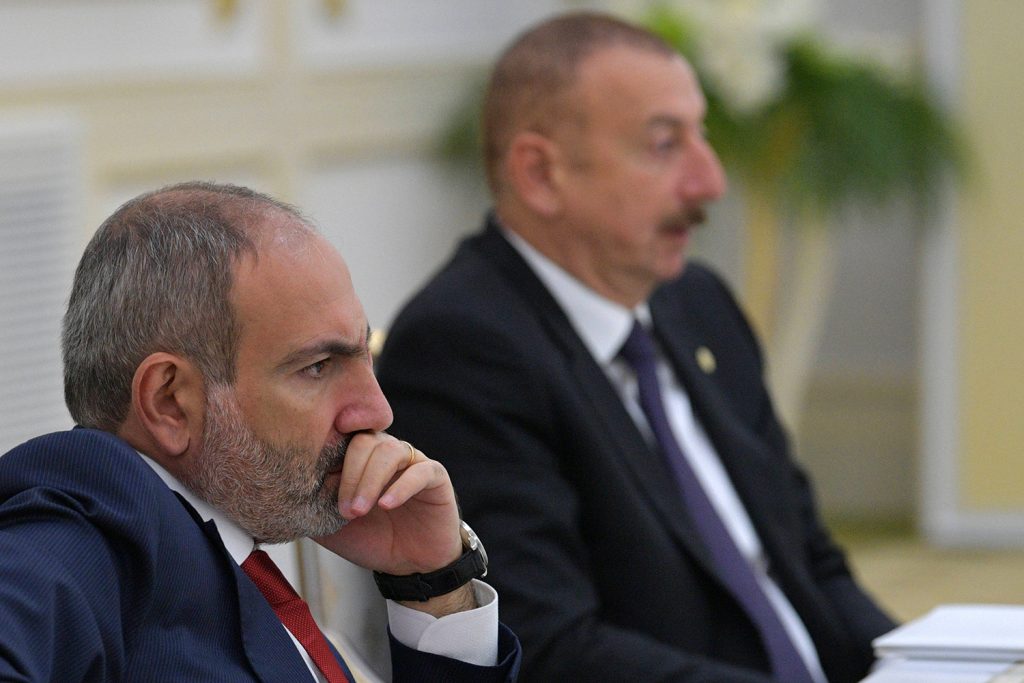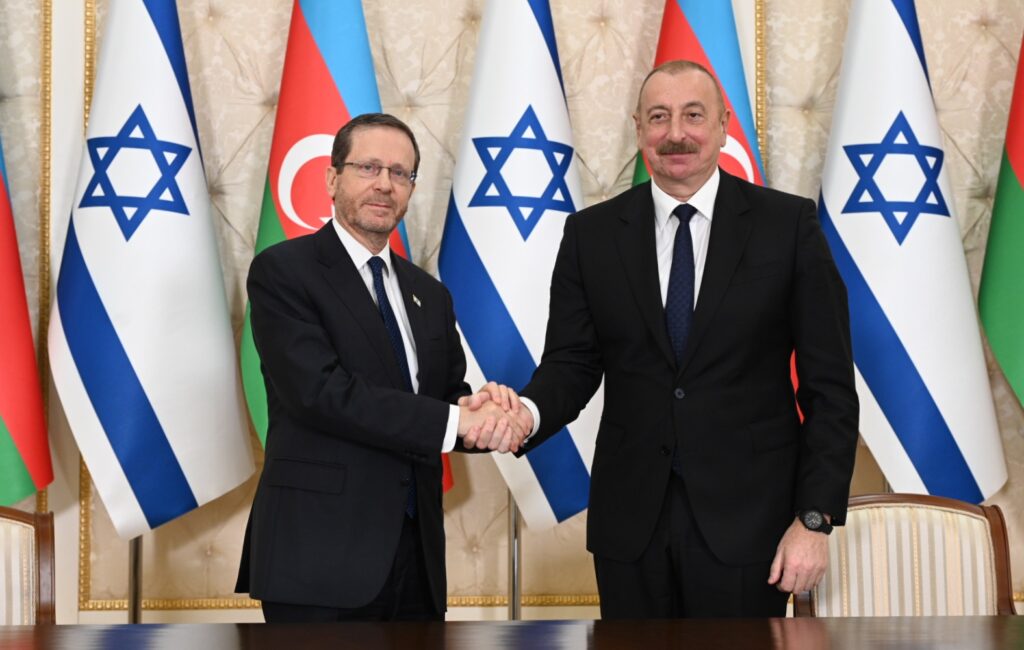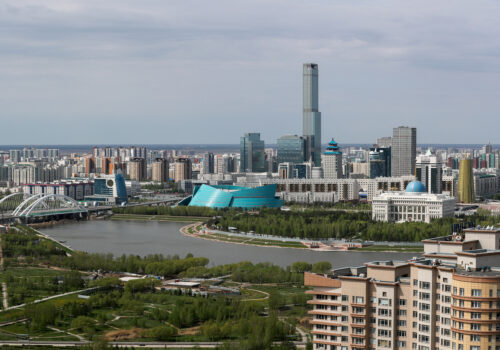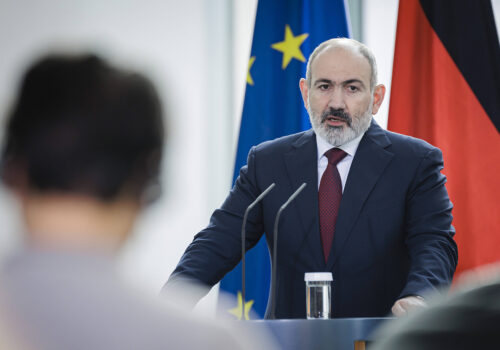Armenia’s ‘crossroads’ offers the US and Israel a rare opportunity
For decades, Armenia and Azerbaijan’s conflict over Nagorno-Karabakh has kept the South Caucasus in a gridlock of historic animosities, closed borders, and economic stagnation. But with the conflict now effectively over, Armenia has launched its “Crossroads of Peace” initiative, envisioning itself as a central Eurasian transit hub.
The project aims to revive long-defunct transport routes—once important arteries of Soviet-era trade—that were severed after Azerbaijan and Turkey closed their borders with Armenia in 1991 and 1993, respectively, thereby isolating it. Restoring these routes would reconnect Armenia with its neighbors and link broader corridors from the Persian Gulf to the Black Sea and from the Caspian Sea to the Mediterranean, facilitating trade between major economies in Asia, Europe, and the Middle East. For both the United States and Israel, supporting this initiative offers a strategic opportunity to enhance regional stability, expand economic influence, and counterbalance adversarial powers like Iran, Russia, and China.

This vision, however, ultimately depends on the successful conclusion of the peace treaty between Armenia and Azerbaijan, which remains stalled largely due to Azerbaijan’s shifting and escalating demands—including calls for constitutional amendments and the dissolution of the OSCE Minsk Group—despite diplomatic consensus over the treaty text and Armenia’s expressed readiness to sign it. Another major underlying issue is Azerbaijan’s insistence on an extraterritorial so-called “Zangezur Corridor”, which would connect it to its exclave Nakhchivan through southern Armenia, but bypassing all Armenian oversight, customs, and security. Armenia, while supportive of connectivity, unequivocally rejects any surrender of sovereignty over its territory.
Nevertheless, Crossroads of Peace still offers Baku significant economic and geopolitical benefits. By reconnecting regional transport networks, including access to Turkey through Armenian territory under Armenian jurisdiction, Azerbaijan could achieve many of its logistical objectives without the contentious demand for a sovereign corridor. This cooperative model would provide Baku with more trade routes to Nakhchivan and beyond, while also gaining international legitimacy and investment through a mutually beneficial and multilateral framework.
Why engagement serves US interests
The entry of US President Donald Trump’s second administration offers an opportune moment for the United States, and potentially Israel, to play an active role in securing a high-profile peace agreement by pushing Azerbaijan to sign the treaty with Armenia. While brokering such a deal would be a diplomatic win in itself, its real payoff lies in unlocking the Crossroads of Peace and thereby delivering meaningful strategic and commercial gains.
By facilitating new trade routes through a Western-friendly, post-conflict South Caucasus, the United States could establish a firmer presence in a region it has long neglected, challenge the dominance of rival powers, and generate economic returns through infrastructure partnerships and transit revenue.
For Washington, the Eurasian transport network represents a unique opportunity to establish a foothold in a region vital to global trade and geopolitics. It offers a Western-aligned alternative to transport networks increasingly dominated by Russia and China while opening the door to US commercial participation in logistics, infrastructure, and technology.
The Eurasian transport network, comprising mainly the Northern Corridor, Middle Corridor, and International North-South Transport Corridor (INSTC), moves millions of tons of freight worth billions of dollars each year. These corridors, which cut across Central Asia, the South Caucasus, and Eastern Europe, are economic battlegrounds where Moscow and Beijing seek to maintain influence, and the West attempts to create alternatives to Russian and Chinese-controlled infrastructure. In this fiercely contested region, controlling trade routes means shaping the future balance of economic and geopolitical power.
SIGN UP FOR THIS WEEK IN THE MIDEAST NEWSLETTER
Despite the strategic importance of these corridors, the United States currently has a very limited regional presence and lacks an integrated strategy or infrastructure footprint, offering only modest support limited to diplomatic engagement and technical assistance for the Middle Corridor, led by Kazakhstan, Azerbaijan, Georgia, and Turkey. However, this corridor faces significant challenges, including limited infrastructure capacity, high costs, and a lack of integration, which undermine its efficiency and deter large-scale, reliable trade flows. It is also partially aligned with China’s Belt and Road Initiative (BRI), with parts of the Middle Corridor physically overlapping with and increasingly integrated into the BRI, drawing it into Beijing’s sphere of influence.
China’s growing interest and investment in the Middle Corridor thus further complicates its appeal for Western stakeholders. Chinese influence is now poised to grow even further with the Anaklia Port—a deep-sea project in Georgia—having been awarded to a Chinese-led consortium. Meanwhile, most freight still flows through Russia via the Northern Corridor, maintaining Moscow’s dominance over Eurasian transport. The INSTC—connecting India, Iran, Russia, and Europe—offers some diversification, but it presents “double trouble” for Washington’s involvement by relying heavily on both Iranian and Russian networks, two countries under sweeping US sanctions.
From a purely economic standpoint, the potential of Crossroads of Peace is substantial. Much of Eurasia’s overland trade currently bypasses Armenia, relying instead on Georgia’s politically sensitive routes and the broader Middle Corridor. Diversifying transit through Armenia would strengthen regional connectivity and unlock new channels for investment, trade, and employment. By investing early in Crossroads of Peace, the United States can counterbalance Moscow and Beijing’s regional footprints while creating entry points for American firms in sectors such as construction, energy, digital infrastructure, and logistics. While comprehensive feasibility studies have yet to be publicly released, the Armenian government has indicated that the project could generate significant economic returns by restoring dormant transit infrastructure and linking key regional corridors. Institutions like the Asian Development Bank have expressed support, and the US-Armenia Strategic Partnership Charter highlights the initiative as a priority area for cooperation.
Moreover, given the Trump administration’s emphasis on economic partnerships and tangible returns, Armenia’s proposal aligns well as a concrete opportunity to advance US financial interests. Infrastructure projects, particularly railways and highways, could generate significant returns through tolls, tariffs, and transit fees, benefiting US investors, US-backed development institutions, and potentially the US federal government if linked to initiatives like an External Revenue Service.
However, the precise mechanisms through which the United States would realize these returns—such as specific investment structures, revenue-sharing agreements, or operational roles—require further elaboration. Detailed financial modeling and bilateral agreements would be necessary to quantify and actualize these benefits. The US International Development Finance Corporation (DFC) could help drive this effort by providing early-stage support and risk mitigation for targeted investments in Crossroads of Peace that lay the groundwork for a sustainable US economic footprint across the South Caucasus. This approach would also dovetail with Trump’s broader ambitions to fund government expenditures through foreign-derived revenue rather than domestic taxation. Investing in Crossroads of Peace could therefore fit neatly into this vision, turning geopolitics into a profitable enterprise benefiting the American taxpayer.
The potential for this initiative to succeed under US sponsorship could redefine Washington’s legacy in the South Caucasus and position the Trump administration as the indispensable peace broker in a region historically dominated by rival powers. Given Trump’s record of bold diplomatic efforts, from Ukraine-Russia negotiations to mediation between Rwanda and the Democratic Republic of Congo—conflicts still far from resolution—brokering peace between Armenia and Azerbaijan would be a comparatively easy win. It would take little more than a decisive push from Trump to “close the deal” and get Azerbaijan to sign onto terms it has already effectively agreed to, delivering a swift and tangible diplomatic victory.
Why engagement serves Israeli interests
Israel, too, has strong incentives to support the finalization of peace and the development of Armenia’s transit ambitions. Azerbaijan is a close Israeli ally, particularly in terms of energy and security cooperation. Helping to solidify peace with Armenia could deepen these ties while promoting broader regional stability. With trade between Israel and Gulf states, particularly the United Arab Emirates, growing rapidly under the Abraham Accords, Israel could benefit from overland corridors like Crossroads of Peace that improve access to Persian Gulf markets, bypass Iran, and create new logistics, infrastructure, and technology cooperation opportunities. This would enhance Israel’s economic outreach and reduce its exposure to Tehran’s influence in regional supply chains.

Additionally, Israel has historic and cultural ties with Armenia, notably through the Armenian Quarter in Jerusalem, home to one of the oldest continuous Armenian diasporas in the world. A peaceful, economically integrated South Caucasus could open new avenues for Israeli trade, diplomacy, and investment across the region.
Furthermore, a secure peace agreement between Armenia and Azerbaijan would significantly reduce Armenia’s dependence on Iran, which has become one of its few trade and energy lifelines due to closed borders with Turkey and Azerbaijan. Armenia’s pragmatic relationship with Iran stems more from necessity than ideological alignment. Opening new trade routes through Azerbaijan and Turkey would enable Armenia to break this dependence and accelerate its Westward pivot.
This shift would directly serve Israel’s interests by further isolating Iran economically while allowing Israel to maintain its foothold in Azerbaijan as a counterweight to Iranian threats. Armenia remains one of Iran’s few accessible and expanding trade partners, with Iranian exports to Armenia reaching nearly 600 million dollars in 2023, including petroleum gas, iron, and other industrial goods. The two countries also maintain strategic energy exchanges—notably under a “Gas for Electricity” agreement—and Armenia is Iran’s only direct link to the Eurasian Economic Union. Reducing Armenia’s dependence on Iran through regional normalization would therefore help close a critical commercial and geopolitical corridor for Tehran. At the same time, a more connected and less Iran-dependent Armenia—at peace with its neighbors and increasingly aligned on common regional security concerns—could adopt a more collaborative stance toward Israel’s interests. Turkish officials have made clear, however, that normalization with Azerbaijan is a necessary precondition for reopening the Turkey-Armenia border.
To this end, leveraging Azerbaijan’s growing interest in joining the Abraham Accords could be instrumental. Although Baku has long maintained strong security and energy relations with Israel, formalizing those relations within the Abraham Accords would significantly elevate its international standing. US Special Envoy Steve Witkoff recently indicated that Armenia, too, could be a candidate for future accession—a development that would further reinforce a regional climate of normalization, mutual recognition, and cooperation. Building on this momentum, US-Israeli joint mediation could help encourage Azerbaijan to soften its stance toward Armenia, facilitating the conclusion of a peace agreement that respects Armenia’s sovereignty while satisfying Azerbaijan’s strategic objectives.
Seizing the opportunity
Finalizing peace between Armenia and Azerbaijan offers Washington and Jerusalem a rare chance to tilt the balance of power in one of the world’s most critical yet contested regions. Investing in this moment and helping to overcome the last obstacles to a peace deal—through targeted diplomacy, infrastructure support, and principled mediation—can help secure new trade corridors, weaken adversaries, and build lasting influence at the crossroads of Europe and Asia. Armenia’s Crossroads of Peace is not merely a reconstruction project but a strategic gateway to a more stable, prosperous, and Western-aligned South Caucasus.
That said, a Westward pivot is not without geopolitical risks. Armenia’s deep historical ties with Russia and Iran could make this realignment contentious, especially if viewed as a zero-sum loss by Moscow or Tehran. To mitigate this, the United States and its allies should pair their investment and mediation efforts with clear security and economic guarantees to Armenia, ranging from energy diversification and trade facilitation to defense cooperation and institutional integration. Framing Crossroads of Peace as a shared regional gain, rather than a Western encroachment, will be essential to ensuring its sustainability.
But this opportunity will not remain open for long. It must be seized now.
Sheila Paylan is a human rights lawyer and senior legal consultant with the United Nations.
* The views expressed herein are her own and do not necessarily reflect those of the United Nations.
Further reading
Mon, May 12, 2025
Azerbaijan and Kazakhstan are the Abraham Accords’ new frontier
MENASource By
Joining the Accords could benefit Baku and Astana, while also helping Israel and the US strengthen engagement with the Turkic world.
Wed, Feb 5, 2025
Armenian Prime Minister Nikol Pashinyan outlines his vision for peace in the region
New Atlanticist By Katherine Golden
“It isn’t possible to have real and thriving independence, prosperity, and security without peace,” Pashinyan argued at an Atlantic Council event.
Tue, Jun 3, 2025
Beyond the gridlock: The case for Tunisia-Israel normalization
MENASource By
The potential for normalization may seem farfetched, but there are many strategic benefits for Tunisia and Israel beyond what meets the eye.
Image: A man in military uniform of Republic of Nagorno-Karabakh tends flocks of sheep with a shepherd from Karabakh on the road in Goris. They said they fled with the flocks of sheep when the conflict happened. Armenia reported on the 3rd October that around 100,625 refugees have arrived from Nagorno-Karabakh while 91,924 of them have been already registered by Armenian officials after Azerbaijan took control of the southern mountainous region. (Photo by Ashley Chan / SOPA Images/Sipa USA)No Use Germany.



